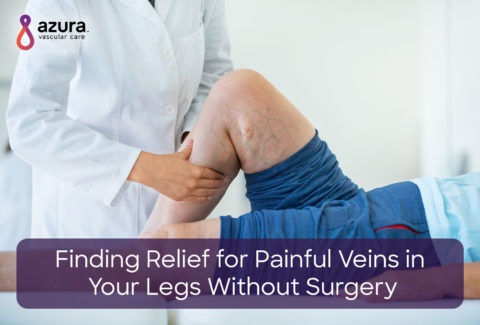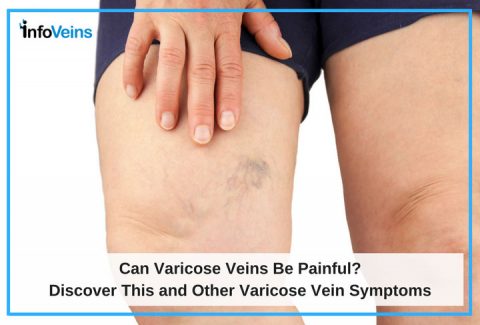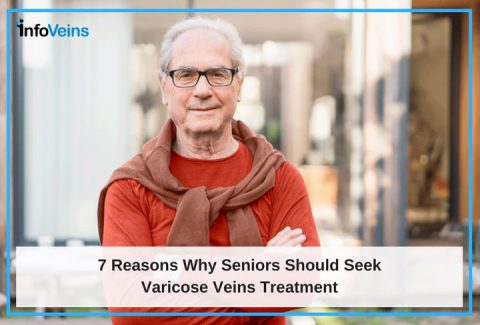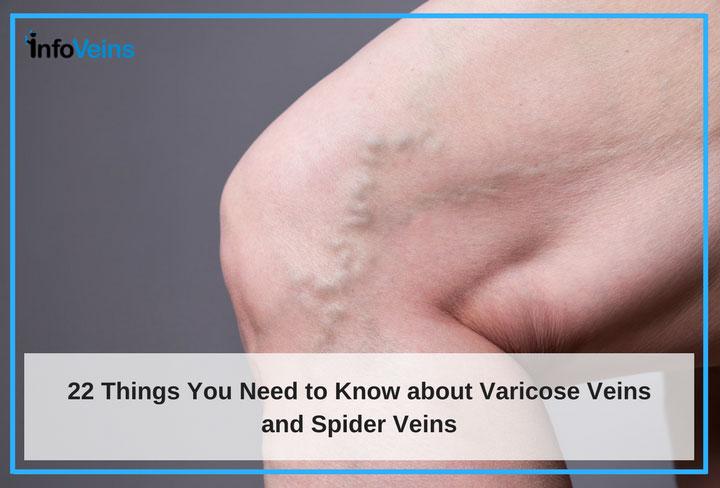
What are varicose veins? Are spider veins different? Do I need to worry if I think I have either of them? Can anything be done?
These are all very natural, common questions that many people have when they’re experiencing what they think may be varicose or spider veins.
Varicose veins, and the smaller version known as spider veins, are abnormal, dilated blood vessels. They often form in the legs. They develop when the valves and walls of the veins are weak, which causes blood to pool in the veins.i This pooling increases the pressure in the veins, and they become enlarged. Whether your doctor has already told you that you have this condition, or if you just suspect that you may have it, there are probably some questions that you have about varicose veins and spider veins.
Varicose Veins and Spider Veins – What is the Difference?
While varicose veins and spider veins have the same cause, there are differences between them:
- Varicose veins are twisted, bulging blue blood vessels that can be seen and felt right under the surface of the skin.
- They can cause a feeling of heaviness, discomfort or swelling in the legs.
- Rarely, they can lead to more serious health conditions such as non-healing sores and/or blood clots.ii
- Treatment may be necessary to prevent varicose veins from worsening and to improve how the legs look and feel.
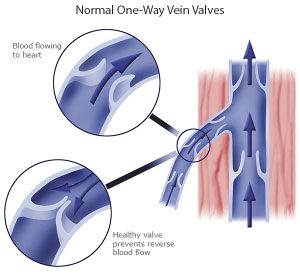
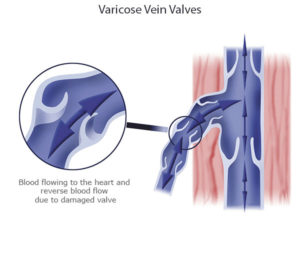
- Spider veins appear as tiny red or blue lines, usually less than 1 mm in diameter, that look like branches or a spider web just below the surface of your skin.iii
- They’re almost always painless, do not cause leg swelling and generally do not lead to other health problems.
- The cause of spider veins is not always leaky one-way valves in the veins, they can be caused by different forms of venous insuffiency.iii
- While someone can have both varicose veins and spider veins, it’s important to point out that spider veins do not always turn into varicose veins.iii
- Treatment of spider veins alone is usually considered cosmetic.
22 Things About Varicose Veins and Spider Veins That You May Not Be Aware Of
- They’re common –About 50 to 55 percent of women and 40 to 45 percent of men in the United States suffer from some type of vein problem. Varicose veins affect half of people 50 years and older.iv
- In the case of varicose veins, they’re not always just a cosmetic problem – they can impact how you enjoy life and can potentially lead to serious health problems.v
- Both varicose veins and spider veins are hereditary – if you have family members with either, it’s not uncommon if you develop them as well.ii
- They can be related to body weight – if you are overweight, you’re more likely to develop them.vi
- They’re gender-related – women are more likely to develop them than men.v
- They’re age-related – as you age, varicose and spider veins are more likely to develop.v
- Varicose veins can develop during pregnancy – but they tend to go away within 3 months after the pregnancy.vii
- Varicose veins are thought to be hormone-related – medications containing female hormones, such as birth control or hormone replacement therapy, increase your risk of developing varicose veins.v
- They can be job-related – if you have a job that involves sitting or standing all day, this may worsen your varicose veins. Crossing your legs can also make them worse, as this position impedes the flow of blood.v
- Varicose veins can cause discomfort – heaviness, tightness, pain with walking and cramps in the legs can be caused by varicose veins.viii
- A doctor may be able to easily diagnose your condition – sometimes a diagnosis can be made based on what you’re feeling and the physical appearance of your legs.
- Duplex ultrasound is the best way to look for varicose veins– this ultrasound imaging test uses sound waves to visualize the veins and measure blood flow.v
- Varicose veins are typically found in the legs – but spider veins are common on both the legs and face.
- Over time, varicose veins can worsen and cause changes in the skin – changes might include sores that do not heal, increased leg swelling and hardening of the skin.v
- Itchy ankles may not just be dry skin – varicose veins can cause itching around the ankles.
- If a varicose vein is injured, it may bleed more than you might expect – excess bleeding can be the result of the increased amount of blood that has pooled within the vein.
- 2-3% of people with varicose veins will develop blood clots – while rare, 25% of the time a clot forms, it can move into the deeper veins, becoming a deep vein thrombosis, a serious condition that needs immediate medical attention.ix Improving the blood flow in your legs now may help you avoid getting blood clots.
- If you develop pain, redness or swelling around a varicose vein, or if you have a sore that is not healing – you should make an appointment to see your doctor.
- Lifestyle changes may help – committing to changes in your daily life such as losing weight and elevating your legs, as well as avoiding sitting or standing for long periods of time, may improve your symptoms.v
- Compression stockings might help – these special knee- or thigh-high stockings are made of elastic and compress the leg. They are often the first treatment for varicose veins.v
- If lifestyle changes and compression stockings don’t help your symptoms, there are other options – some varicose vein treatments that can relieve symptoms and improve the look of your legs may include minimally invasive procedures, such as endovenous ablation, sclerotherapy or microphlebectomy. Or, there are more invasive options like vein ligation and stripping surgery, which involve tying off the veins and removing them.
- Your insurance may cover varicose veins treatment
RELATED: 6 Hidden Dangers if You Don’t Treat Varicose Veins
Hopefully, by now, you feel confident in knowing the difference between varicose veins and spider veins. If you suspect you have varicose veins and you’re wondering what you can do to prevent them from worsening or you’re hoping to find relief from any discomfort or swelling, you should see your doctor. Talk to your doctor about the best options for treatment and ask if minimally invasive procedures are right for you. You may not need surgery to get relief. And remember, if you have pain, redness, warmth and/or swelling around a varicose vein, seek medical attention now.
Sources:
iMayo Clinic. Varicose Veins Overview. http://www.mayoclinic.org/diseases-conditions/varicose-veins/home/ovc-20178078 (updated 1/22/2016, accessed 11/30/2016)
iiNational Heart, Lung and Blood Institute. Who Is at Risk for Varicose Veins? https://www.nhlbi.nih.gov/health/health-topics/topics/vv/atrisk (updated 1/29/2016, accessed 11/30/2016)
iiiMujadzic, M., Ritter, E.F., Givens, K.F., A Novel Approach for the Treatment of Spider Veins. Anesthet Surg J, 2015. 25(7): NP221-NP229. https://www.ncbi.nlm.nih.gov/pmc/articles/PMC4551823/
ivVaricose Veins and Spider Veins, Frequently Asked Questions. U.S. Department of Health and Human Services, Office on Women’s Health. http:/www.womenshealth.gov.
vPiazza, G., Varicose Veins. Circulation, 2014. 130: p. 582-587. http://circ.ahajournals.org/content/130/7/582.long
viDavies, H., Popplewell, M., Singhal, R., Smith, N., Bradbury, A., Obesity and lower limb venous disease – The epidemic of phlebesity. Phlebology, 2016. May 13. pii: 0268355516649333. https://www.ncbi.nlm.nih.gov/pubmed/27178403
viiAsbeutah, A., Al-Azemi, M., Al-Sarhan, S., Almajran, A., Asfar, S., Changes in the diameter and valve closure time of leg veins in primigravida women during pregnancy. J Vasc Surg Venous Lymphat Disord, 2015. 3(2): p. 147-153 https://www.ncbi.nlm.nih.gov/pubmed/26993832
viiiWrona, M., Jockel, K., Pannier, F., Bock, E., Hoffmann, B., Rabe, E., Association of Venous Disorders with Leg symptoms: Results from the Bonn Vein Study 1. Eur J Vasc Endovasc Surg, 2015. 50: p. 260-267. http://www.ejves.com/article/S1078-5884(15)00333-0/pdf
ixRikimaru, H., Clinical Features and Developing Risks of Saphenous Vein Thrombophlebitis. Ann Vasc Dis, 2016. 9(2): p. 85-90. https://www.ncbi.nlm.nih.gov/pmc/articles/PMC4919299/
xWebMD. Varicose Veins and Spider Veins. http://www.webmd.com/skin-problems-and-treatments/cosmetic-procedures-spider-veins#3 (accessed 12/2/2016)
